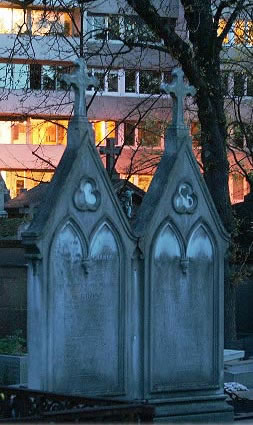These darkening days of autumn are a mysterious time, marking the waning year and filled with a sense of the inevitable. Those who follow astrology know this is the season of Scorpio, the sign associated with the death and transformation that leads to change, renewal and regeneration of life. At the center of this season is Halloween, the modern version of the ancient Celtic holiday Samhain (pronounced sa-wen).

Matching designer graves at Pere Lachaise, not too far from where Jim Morrison is buried, on Day of the Dead 2005. Photo by Eric Francis.
It may seem like a coincidence that the scary costumes, candle-lit walks to old cemeteries and, for the faithful, the vigils inviting the spirits of ancestors home for All-Hallow’s Eve align with the astrological sign of the mysteries of death. But when you consider, in the words of Donna Henes in her book Celestially Auspicious Occasions, that Halloween’s symbols — “the ghosts, masks, fires and food — are the same as they were thousands of years ago in ancient Egypt,” it’s clear that Scorpio is part of an unbroken chain of tradition through cultures worldwide.
From the temples on the Nile millennia before the birth of Jesus, through the rise of the Christian movement with its co-opting of local religion, its crusades and inquisitions; from ancient Aztec cultures to Mexico, Spain and Portugal of recent centuries, and even through to modern-day marketing culture, the traditions of Halloween carry a common signature, an identifying mark. Even skeptics who are paying attention must make note that there is something inherent and natural about this time of year for these symbols to arise from the collective consciousness in so many cultures.
In astrology, the “death” symbolism of Scorpio aligns with the tradition of welcoming the spirits of the dead on what the Christians later called All Soul’s Night. The grim reaper appears in the season of the final harvest. Historically, this was the time of year when final preparations were being made for the winter that lay ahead by harvesting anything that was left in the fields. In addition, the ancients assessed their livestock and decided which animals were to be slaughtered and preserved for the food that would be eaten during the many cold months to come. The Celts knew that they could only sustain the smallest of herds in the coming months.
It is important to understand that this was a very serious time. In many climates, particularly Ireland, from where most of our Halloween traditions originate, winters were cold and harsh, and the mortality rate was very high. Medicines were made with herbs for the inevitable illnesses to come. Nobody knew for sure who would make it through the long winter, which was, in the harsh climates, a time when many lives ended.
It is no wonder, then, that the opposite Celtic holiday, Beltane, or May Day, is a celebration of fertility and sex, for it was understood that the more joyous and passionate was Beltane, the more fruitful the harvest of the following autumn, and the greater the chances of life being sustained through the following winter. As modern society continues to conquer nature, one may say that these obvious facts of life are departing from our awareness. But the prevalence of Halloween and its images is reassuring.
Traditionally, October 31, Samhain, is a time for communing with the dead, the time of year when it is believed that the veils between the worlds are the thinnest. One tradition is called a “Dumb” or “Silent Supper.” Ceremonies are performed in honor of those we love that have passed, and we set a place at the table for the departed with offerings of bread and wine so that the dead may feast, eating in silence and remembering loved ones.
All of this is consistent with the familiar astrological themes of Scorpio, which we associate with psychic powers and communicating with the dead. Indeed, traditionally, this season was also the time of casting divination on the question of marriage, an attribute connected with Scorpio and the corresponding Eighth House and theme of sexual consummation. In the oldest astrology textbook in English, William Lilly suggests that the Eighth House is the house of “death and dowry.”
The scorpion symbolism of this sign has been related to sex through the act of the scorpion’s sting, which is a pessimistic interpretation. Yet “in Mesopotamian mythology,” says the Astrology Encyclopedia by James R. Lewis, “scorpion men guarded the gates of the underworld, which is the original reason Scorpio became associated with death.” The snake sheds its skin; all things must change; the cycle of birth and death continues throughout the life of the Earth in an unbroken chain of life and tradition of which Halloween, Samhain or All Hallow’s Eve is a defining moment worldwide.
Writes the Wiccan mystic Starhawk, “We are not separate from each other, from the broader world around us. We are one with the Goddess, with the God. As the cone of power rises, as the season changes, we arouse the power within, the power to heal, the power to change our society, the power to renew the Earth.”
Additional Research: Jenny Singer and Carol Burkhart


“Looking for familiar faces, in an empty windowpane…”
Nicely done Eric, an important re-counting of the meaning of this time of the solar cycle.
I’ve taken part in a few Dumb Suppers. It’s a lovely tradition.
This article reminds me of Terry Pratchett’s invention of the Dark Morris for his Discworld series, reasoning, as he put it, that “the seasons might need more than one push”.